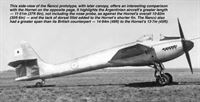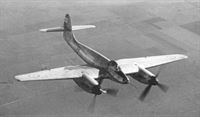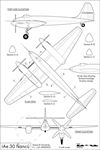
Описание
Страна : Аргентина
Год : 1948
Единственный экземпляр
Одноместный истребитель сопровождения
FMA I.Ae.30 Namcu
Одноместный двухмоторный истребитель сопровождения I.Ae.30 Namcu ("Орленок") разработан по заказу ВВС Аргентины инженером К. Паллавичино. Моноплан цельнометаллической конструкции со свободнонесущим крылом и убираемым шасси с хвостовым колесом, силовая установка - два мотора Rolls-Royce Merlin. Прототип выполнил первый полет 18 июля 1948 года, в начале августа прототип перелетел из Кордобы в Буэнос-Айрес со средней скоростью 650 км/ч при примерно 60% мощности двигателей. Столь высокие летные данные, дополненные отличной маневренностью, стали достаточным основанием для заказа ВВС Аргентины партии из 210 самолетов. Однако по финансовым причинам заказ выполнен не был, а дальнейшие работы по программе свернули.
ТАКТИКО-ТЕХНИЧЕСКИЕ ХАРАКТЕРИСТИКИ
FMA I.Ae.30 Namcu
Тип: одноместный истребитель сопровождения
Силовая установка: два V-образных 12-цилиндровых мотора Rolls-Royce Merlin 134/135 мощностью по 2035 л. с. (1517 кВт) Масса: пустого 5585 кг; максимальная взлетная 8755 кг
Размеры: размах крыла 15,00 м; длина 11,52 м; высота (включая хвостовое оперение) 5,16 м; площадь крыла 35,32 м
Вооружение (предполагаемое): шесть 20-мм пушек Hispano в фюзеляже и одна 250-кг бомба на подвеске под фюзеляжем
- Описание
Фотографии
-
Aviation Historian 35 / R.Lezon, S.Rivas - The patagonian eagle
The prototype in bare metal, with early canopy, soon after completion at the IAe factory at Cordoba. The prominent Merlin 130-series engines were designed as "slimline” variants with minimal frontal area specifically for the D.H.103 Hornet.
-
Aviation Historian 35 / R.Lezon, S.Rivas - The patagonian eagle
The prototype with FAeA roundels added, but without its military serial, I-101, which was never applied to the aircraft. The glazed nose and long probe were fitted for the trials programme, but would have been replaced on production examples with a solid nose and a quartet of Hispano-Suiza 20mm cannon. Note also the radiator- and oil-cooler intakes in the wings inboard of the engines; the carburettor intakes were in the outer wings.
-
Aviation Historian 35 / R.Lezon, S.Rivas - The patagonian eagle
The prototype warms up at Cordoba for another test flight. Although the Nancu was unquestionably a promising design and a remarkable achievement for a relatively inexperienced industry, it was developed at a time when the future of fighters was inevitably jet-powered.
-
Aviation Historian 35 / R.Lezon, S.Rivas - The patagonian eagle
This side-view of the Nancu prototype, with later canopy, offers an interesting comparison with the Hornet, It highlights the Argentinian aircraft’s greater length - 11-51m (37ft 9in), not including the nose probe, as against the Hornet’s overall 10-82m (35ft 6in) - and the lack of dorsal fillet added to the Hornet’s shorter fin. The Nancu also had a greater span than its British counterpart - 14-94m (49ft) to the Hornet’s 13-7m (45ft).
-
Aviation Historian 35 / R.Lezon, S.Rivas - The patagonian eagle
Showing its sleek lines and prominent nacelles housing its Rolls-Royce Merlin 130-series engines, the IAe.30 Nancu prototype is seen here at the lAe factory at Cordoba in central Argentina.
-
Air Enthusiast 2001-09 / A.Marino, V.Celleto, J.Mosquera - Argentina's 'Heavies' (1)
The IAe-30 Namcu fighter, designed by the Institute Aerotecnico - subject of trials by Lancastrian T-65.
-
Aviation Historian 35 / R.Lezon, S.Rivas - The patagonian eagle
FMA I.Ae.30 Namcu мог бы стать великолепным боевым самолетом для ВВС Аргентины, по вооружению и летным данным превосходящим любой другой латиноамериканский самолет послевоенного периода. Но недостаток финансовых средств не позволил организовать его серийное производство.
On its return from Bolivia some modifications were made to the Nancu prototype. The original one-piece windscreen was replaced with a flat armoured front windscreen with two Perspex side panels. Aileron control was extremely heavy at high speeds and spring-tabs were fitted to provide improved lateral control at speeds up to the maximum permissible. -
Aviation Historian 35 / R.Lezon, S.Rivas - The patagonian eagle
A fine air-to-air study of the prototype over the Sierras Chicas mountains while up on a test flight from Cordoba. Of particular note in this view is the much higher-set tailplane of the Nancu compared to the Hornet, the tailplane of which was in a more conventional position at the base of the distinctive de Havilland fin.
-
Aviation Historian 35 / R.Lezon, S.Rivas - The patagonian eagle
Teniente Primero Edmundo Osvaldo Weiss (left) and Cesare Pallavicino pose for a photograph in front of the IAe.30 prototype. Having designed aircraft for Breda and Caproni in Italy before the war, Pallavicino co-designed the Lambretta motor scooter before emigrating to Argentina in 1946.
-
Aviation Historian 35 / R.Lezon, S.Rivas - The patagonian eagle
The prototype IAe.30 Nancu under construction in the IAe hangar at Cordoba in the second half of 1947. This aircraft reportedly took more than 370,000 manhours to build, but was completed in a remarkable 11 months.
-
Aviation Historian 35 / R.Lezon, S.Rivas - The patagonian eagle
The IAe.30's wing was a one-piece cantilever structure incorporating two spars. The wing’s taper was kept as sharp as possible to conserve the aircraft’s roll performance and the tip was squared to permit the aileron to extend outboard as far as possible, again to enhance roll quality. The control surfaces were metal-covered; Alclad ailerons and hydraulically-operated split flaps, divided by the engine nacelles, were fitted.
-
Aviation Historian 35 / R.Lezon, S.Rivas - The patagonian eagle
A view inside the slim and elegant “pear-shaped” curved-triangular-section fuselage of the prototype during construction. The structure was conventional, comprising alloy frames and top-hat-section stringers, to which the outer Alclad skin was riveted.
-
Aviation Historian 35 / R.Lezon, S.Rivas - The patagonian eagle
The last remaining souvenir of the IAe.30 Nancu - a sectioned example of one of its two Rolls-Royce Merlin 130-series engines - remains on display at the Museo Universitario de Tecnologia Aeroespacial in Cordoba, along with a model of the aircraft.
-
Aviation Historian 35 / R.Lezon, S.Rivas - The patagonian eagle
A sad end for the sole Nancu - after Capitan Carlos Fermin Bergaglio’s landing accident in November 1951, the aircraft’s remains were dragged to a corner of the airfield at Cordoba and left to rot into the weeds before finally being scrapped.
-
Aviation Historian 35 / R.Lezon, S.Rivas - The patagonian eagle
A 1/24-scale wooden model of the IAe.30 discovered by author Ricardo Lezon during a visit to Cordoba in 2013. It is not a windtunnel model, as no such testing was undertaken on the design, so it is thought to be a model of the prospective production version, with a solid nose, reshaped canopy, and with evidence that a dorsal fillet was also to be fitted.
-
Aviation Historian 35 / R.Lezon, S.Rivas - The patagonian eagle
A full-scale mock-up of the production version of the IAe.30 in the hangar at Cordoba, incorporating design revisions including a solid nose, a lower-set tailplane and a dorsal fillet similar to that of the Hornet, plus a single-piece rudder and the reconfigured cockpit canopy.
- Фотографии
















